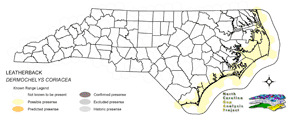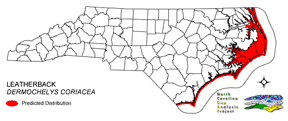
| Taxa: |
| Order: |
| Family: |
| Reptilia |
| Testudines |
| Dermochelyidae |
| NatureServe Global Rank: |
| NatureServe State (NC) Rank: |
| G3 |
| SZN |
| Federal Status: |
| NC State Status: |
| LE |
| E |


| Land Unit |
| US Fish & Wildlife Service |
| US Forest Service |
| US National Park Service |
| US Department of Defense |
| NC State Parks |
| NC University System |
| NC Wildlife Res. Com. |
| NC Forest Service |
| NC Div. of Coastal Mgmt. |
| Local Governments |
| Non-Governmental Org. |
| Other Public Lands |
| Private Lands |
| GAP Status 1-2 |
| All Protected Lands |
| Statewide |
| Hectares |
| 346.05 |
| 4.59 |
| 253.89 |
| 1,012.59 |
| 112.14 |
| 0.00 |
| 29.34 |
| 0.00 |
| 206.91 |
| 0.00 |
| 39.69 |
| 0.36 |
| 3,327.75 |
| 1,297.35 |
| 2,003.13 |
| 5,333.31 |
| Acres |
| 855.11 |
| 11.34 |
| 627.38 |
| 2,502.16 |
| 277.10 |
| 0.00 |
| 72.50 |
| 0.00 |
| 511.29 |
| 0.00 |
| 98.08 |
| 0.89 |
| 8,223.05 |
| 3,205.82 |
| 4,949.84 |
| 13,178.89 |
| % of Dist. on |
| Prot. Lands |
| 17.3 % |
| 0.2 % |
| 12.6 % |
| 50.6 % |
| 5.6 % |
| 0.0 % |
| 1.5 % |
| 0.0 % |
| 10.3 % |
| 2.0 % |
| 2.0 % |
| < 0.1 % |
| 0.0 % |
| 64.8 % |
| ----- |
| ----- |
| % of Dist. on |
| All Lands |
| 6.5 % |
| < 0.1 % |
| 4.8 % |
| 19.0 % |
| 2.1 % |
| 0.0 % |
| 0.6 % |
| 0.0 % |
| 3.9 % |
| 0.0 % |
| 0.7 % |
| < 0.1 % |
| 62.4 % |
| 24.3 % |
| ----- |
| ----- |
|
The leatherback is primarily a tropical nester but is known to wander more widely than other sea turtles. One nesting record exists from Cape Lookout (Martof et al. 1980). This species is the most pelagic of the sea turtles (Martof et al. 1980) but it occasionally enters shallow bays and estuaries. Nests on beaches free of abrasive rocks and coral, and with a slope of 8-12 degrees. The sand is usually course, with a high silica content, and an abundance of broken mollusk shells. After nesting, it follows schools of jellyfish to temperate waters, then returns to the tropics (Ernst et al. 1994). Nests are dug in sand, and many are lost due to high tides. Invertebrates are the main dietary staple, especially jellyfish, which are eaten at or near the surface of the water. The turtles sleep while floating on the surface (Ernst et al. 1994). NATURE SERVE GLOBAL HABITAT COMMENTS: Marine; open ocean, often near edge of continental shelf; also seas, gulfs, bays, and estuaries. Mainly pelagic, seldom approaching land except for nesting (Eckert 1992). Concentrates in summer in waters mostly 20-40 m deep near Cape Canaveral, Florida. Dives almost continuously, to depths of up to at least several thousand meters; may linger at the surface at midday but spends most of time submerged. Nests on sloping sandy beaches backed up by vegetation, often near deep water and rough seas. Largest colonies use continental, rather than insular, beaches (CSTC 1990). Absence of a fringing reef appears to be important. Deposits eggs in moist sand. Individuals sometimes change to different nesting beach between nestings during a single year; changed to sites 30-110 km away in West Indies (Eckert et al. 1989; see also Copeia 1993:1010-1017). May rapidly occupy newly formed nesting habitat (Pritchard 1992). NATURE SERVE STATE HABITAT COMMENTS: Primarily found over continental shelf offshore NC. |
| Code | Name | Description | NC Natural Heritage Program Equivalent |
| 378 | Ocean Beaches | Open beach sand. | Upper Beach |
| 371 | Maritime Grasslands | Dune grass community consisting of sea oats and beach grasses. | Dune grass, Maritime dry grassland |
| 8 | Open water | Open water without aquatic vegetation. | No equivalent |
|
U.S. Fish & Wildlife Service. 1980. Selected vertebrate endangered species of the seacoast of the United States-- leatherback sea turtle. FWS/OBS-80/01.12.
Lazell, J.D., Jr. 1980. New England waters:critical habitat for marine turtles. Copeia 1980:290-295. Eckert, K. L., and S. A. Eckert. 1988. Pre-reproductive movements of leatherback sea turtles (DERMOCHELYS CORIACEA) nesting in the Caribbean. Copeia 1988:400-406. Goff, G. P., and J. Lien. 1988. Atlantic leatherback turtles, DERMOCHELYS CORIACEA, in cold water off New Foundland and Labrador. Canadian Field-Naturalist 102:1-5. Eckert, S. A. 1992. Bound for deep water. Natural History, March 1992, pp. 28-35. Frazer, N. B. 1992. Sea turtle conservation and halfway technology. Conservation Biology 6:179-184. Pritchard, P. C. H. 1992. Leatherback turtle DERMOCHELYS CORIACEA (Vandelli). Pages 214-218 in P. E. Moler, editor. Rare and endangered biota of Florida. Vol. III. Amphibians and reptiles. Univ. Press of Florida. Conant, R. and J. T. Collins. 1991. A field guide to reptiles and amphibians:eastern and central North America. Third edition. Houghton Mifflin Co., Boston, Massachusetts. 450 pp. Shoop, C. R., and R. D. Kenney. 1992. Seasonal distributions and abundances of loggerhead and leatherback sea turtles in waters of the northeastern United States. Herpetology Monongraphs 6:43-67. Pritchard, P. C. H. 1980. Dermochelys coriacea. Cat. Am. Amph. Rep. 238.1-238.4. Ernst, C. H., R. W. Barbour, and J. E. Lovich. 1994. Turtles of the United States and Canada. Smithsonian Institution Press, Washington, D.C. xxxviii + 578 pp. Chan, E.-H. 1989. White spot development, incubation and hatching success of leatherback turtle (DERMOCHELYS CORIACEA) eggs from Rantau Abang, Malaysia. Copeia 1989:42-47. Eckert, K. L., et al. 1989. Inter-nesting migrations by leatherback sea turtles (DERMOCHELYS CORIACEA) in the West Indies. Herpetologica 45:190-194. Eckert, K. L., and S. A. Eckert. 1989. The application of plastic tags to leatherback sea turtles, DERMOCHELYS CORIACEA. Herpetol. Rev. 20:90-91. Fritts, T. H., W. Hoffman, and M. A. McGehee. 1983. The distribution and abundance of marine turtles in the Gulf of Mexico and nearby Atlantic waters. J. Herpetology 17:327-344. Mrosovsky, N., and M. Benabib. 1990. An assessment of two methods of sexing hatchling sea turtles. Copeia 1990:589-591. Ernst, C. H., and R. W. Barbour. 1972. Turtles of the United States. Univ. Press of Kentucky, Lexington. x + 347 pp. McKeown, S. 1978. Hawaiian reptiles and amphibians. Oriental Pub. Co., Honolulu. 80 pp. Martof, B. S., W. M. Palmer, J. R. Bailey, and J. R. Harrison, III. 1980. Amphibians and reptiles of the Carolinas and Virginia. University of North Carolina Press, Chapel Hill, North Carolina. 264 pp. Meylan, A., P. Meylan, and A. Ruiz. 1985. Nesting of DERMOCHELYS CORIACEA in Caribbean Panama. J. Herpetology 19:293-297. Bjorndal, K. A., editor. 1982*. Biology and conservation of sea turtles. Smithsonian Institution Press, Washington, D.C. 583 pp. *Copyright date; date on title page is "1981.". Van Meter, V. B. 1983. Florida's sea turtles. Florida Power & Light Company, Miami. 46 pp. Marine Turtle Recovery Team. 1984. Recovery plan for marine turtles (loggerhead turtle, green turtle, leatherbackturtle, hawksbill turtle, and Kemp's ridley turtle). Natl. Mar. Fish. Serv. and U.S. Fish and Wildife Service 363 pp. Pritchard, P. C. H., and P. Trebbau. 1984. Turtles of Venezuela. Society for the Study of Amphibians and Reptiles. 403 pp. Eckert, K. L. 1987. Environmental unpredictability and leatherback sea turtle (DERMOCHELYS CORIACEA) nest loss. Herpetologica 43:315-323. Ernst, C. H., and R. W. Barbour. 1989. Turtles of the world. Smithsonian Institution Press, Washington, D.C. xii + 313 pp. National Marine Fisheries Service and U.S. Fish and Wildlife Service. 1995. Status reviews for sea turtles listed under the Endangered Species Act of 1973. National Marine Fisheries Service, Silver spring, Maryland. vi + 139 pp. King, F. W., and R. L. Burke, editors. 1989. Crocodilian, tuatara, and turtle species of the world:a taxonomic and geographic reference. Association of Systematics Collections, Washington, D.C. 216 pp. Committee on Sea Turtle Conservation (CSTC), National Research Council (U.S.). 1990. Decline of the Sea Turtles:Causes and Prevention. National Academy Press, Washington, D.C. xv + 259 pp. U.S. Fish and Wildlife Service (USFWS). 1990. Endangered and threatened species recovery program:report to Congress. 406 pp. Matthews, J. R., and C. J. Moseley (editors). 1990. The Official World Wildlife Fund Guide to Endangered Species of North America. Volume 1. Plants, Mammals. xxiii + pp 1-560 + 33 pp. appendix + 6 pp. glossary + 16 pp. index. Volume 2. Birds, Reptiles, Amphibians. Iverson, J. B. 1991. Patterns of survivorship in turtles (order Testudines). Canadian J. Zoology 69:385-391. Chua, T. H. 1988. Nesting population and frequency of visits in DERMOCHELYS CORIACEA in Malaysia. J. Herpetology 22:192-207. Chua, T. H., and J. I. Furtado. 1988. Nesting frequency and clutch size in DERMOCHELYS CORIACEA in Malaysia. J. Herpetology 22:208-218. Mitchell, J. C. 1991. Amphibians and reptiles. Pages 411-76 in K. Terwilliger (coordinator). Virginia's Endangered Species:Proceedings of a Symposium. McDonald and Woodward Publishing Company, Blacksburg, Virginia. Tucker, A. D., and N. B. Frazer. 1991. Reproductive variation in leatherback turtles, DERMOCHELYS CORIACEA, at Culebra National Wildlife Refuge, Puerto Rico. Herpetologica 47:115-124. |
For more information please contact them at:
NC-GAP Analysis Project
Dept. of Zoology, NCSU
Campus Box 7617
Raleigh, NC 27695-7617
(919) 513-2853
www.basic.ncsu.edu/ncgap